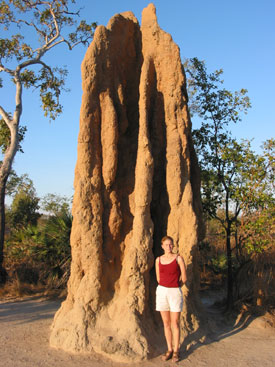Two stages of emergence characterize termite evolution, and may characterize economic development. What would that mean for development theory?
 |
| Source of image |
Termites are tiny, with quite simple nervous systems. The construction and maintenance of such a nest, huge with respect to the individual insects that build them. is not the result of conscious planning. Rather certain conditions elicit certain behaviors from the colony from which emerge the mounds. Mound building is an emergent behavior of the simple behavioral repertoire of the species. Importantly, one would not suspect examining the behavior of a single termite that the colony would construct such an edifice.
Not there are some 4,000 species of termites. Not all build huge mounds, but the mounds are found in species widely separated geographically. Mound building therefore must be a colony behavior that is within the repertoire of the termite gene pool, and under certain conditions a species evolves that builds large mound nests. This too is an emergent behavior of the gene pool, since it would be hard to predict looking at the genes that they had the potential to evolve termites that would behave so that mounds would emerge from the behavior. Indeed, scientists are still working to unravel the complex process of individual, kin and group selection that leads to such evolutionary species emergence.
Thus mound building may be a double emergence, species evolving from the gene pool and huge constructions emerging from the simple behaviors of the species.
From the behavior of the many individuals in some societies have emerged structures of institutions and policies that produce economic prosperity and political freedom for the members of those societies. Not all societies have done so. Yet all human beings are genetically very similar, and people by the hundreds of millions have gone from one to another society, integrating well into the social behaviors of the new society.
In humans, culture seems to be a second channel for the determination of behavior. It would seem that some cultures have emerged that foster social and economic development, while others have not emerged those features necessary for social and economic development. Perhaps we should consider socio-economic development also as a double emergence -- the emergence of a development culture from which emerges the socio-economic structure of prosperity and freedom.
In studying termites it would be futile to seek to understand the conditions under which a species that has not evolved to build mounds would build mounds. Such an effort would be focusing on the wrong emergence process. Might it be that seeking to understand socio-economic development in a culture that has not evolved the capacity for such development is equally misguided?
"A property of a complex system is said to be emergent just in case, although it arises out of the properties and relations characterizing its simpler constituents, it is neither predictable from, nor reducible to, these lower-level characteristics."
Prof. Jaegwon Kim, Oxford Companion to Philosophy
No comments:
Post a Comment